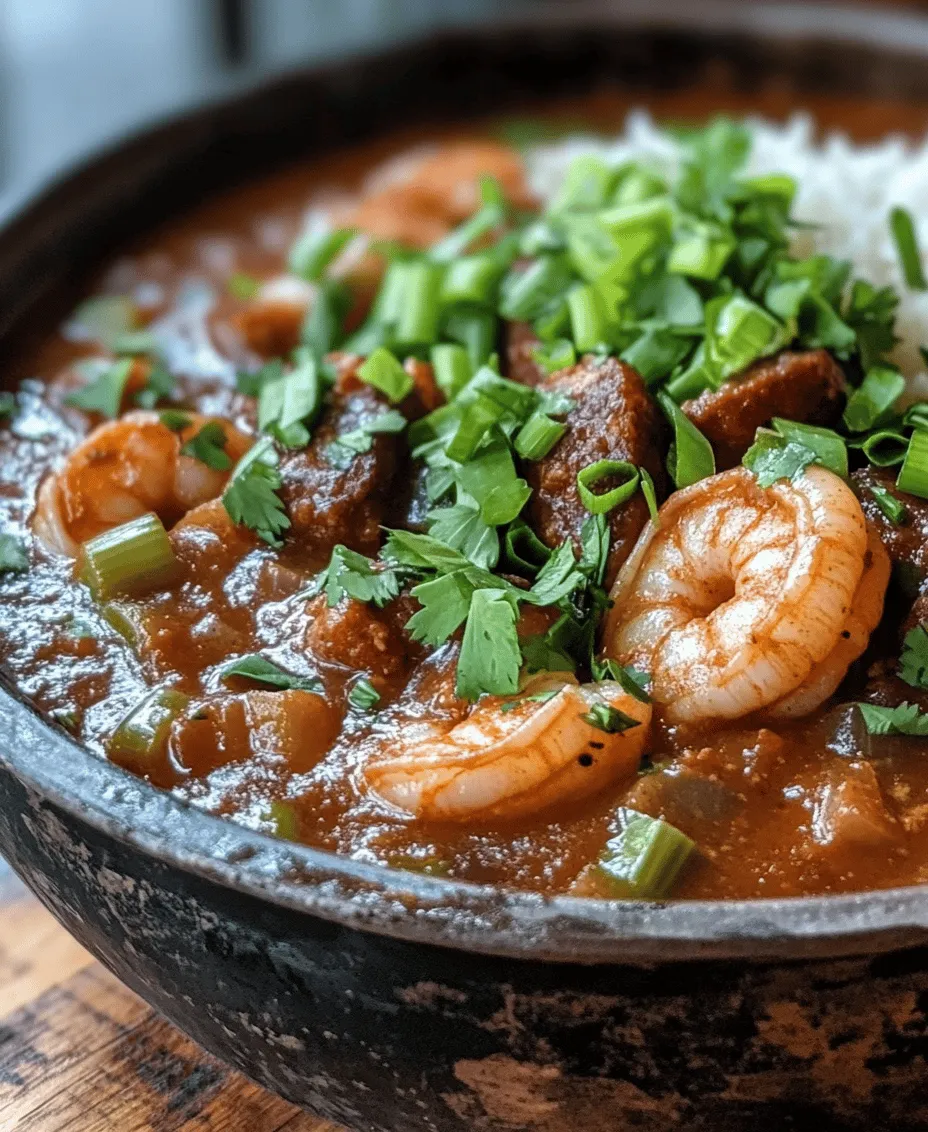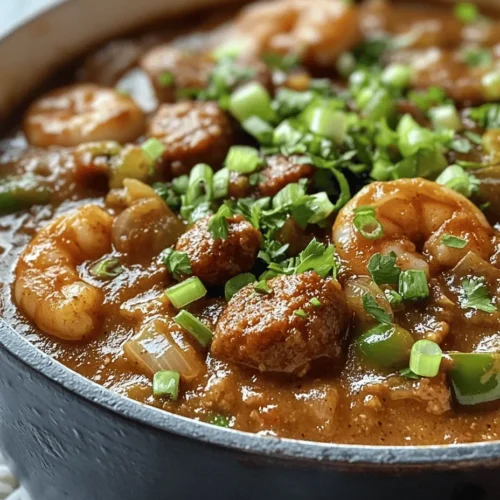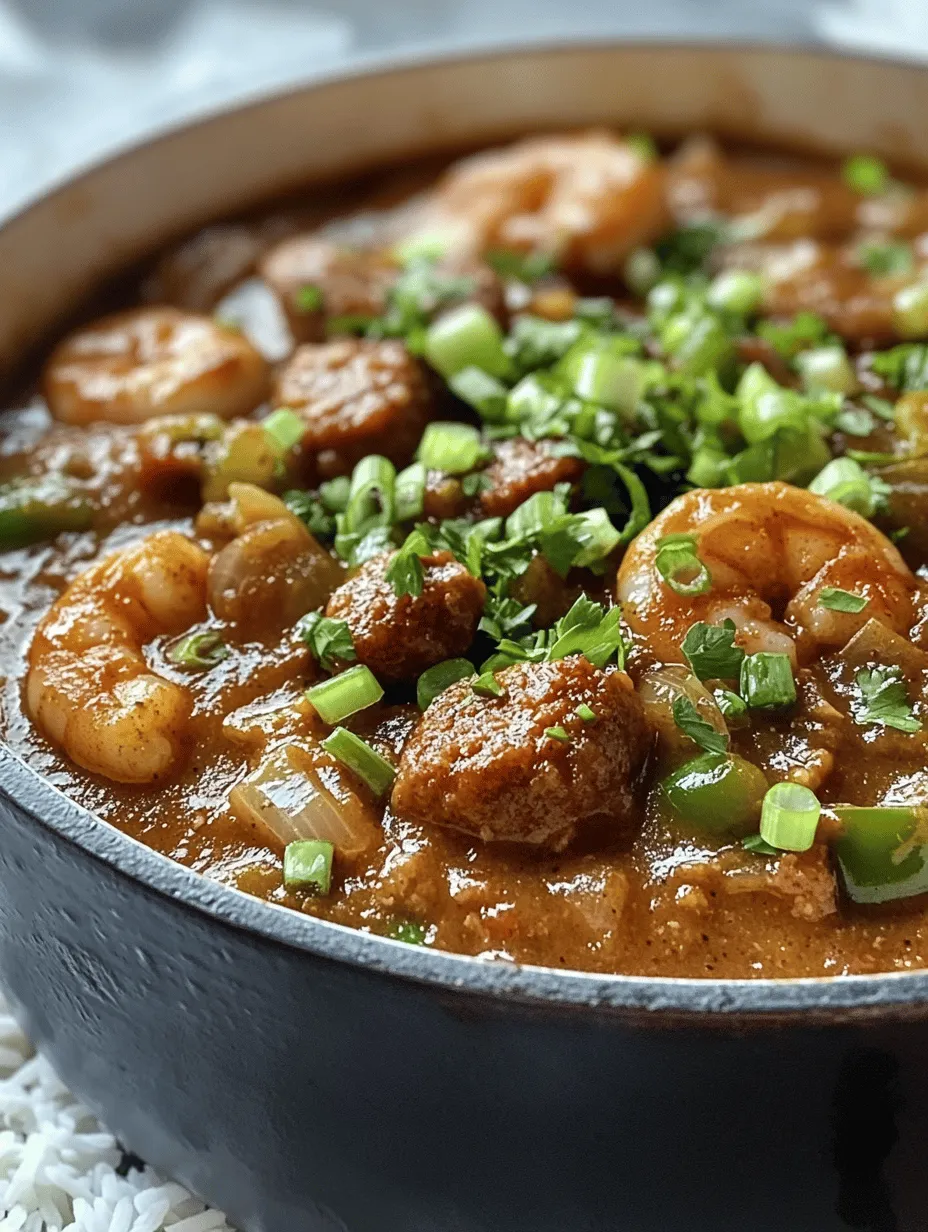Introduction
Gumbo is more than just a dish; it’s a flavorful experience steeped in the rich cultural heritage of Louisiana. Originating from the vibrant fusion of Cajun and Creole traditions, this hearty stew celebrates the diverse influences of French, African, Spanish, and Native American cuisines. It’s a dish that tells a story, one simmered over time, reflecting the history of its people and the land they inhabit. Whether served at family gatherings, festive celebrations, or simply enjoyed on a cozy night in, gumbo embodies the spirit of comfort food.
In this article, we will delve into the world of gumbo, specifically focusing on a delightful recipe for Savory Shrimp and Sausage Gumbo. This dish elegantly combines succulent shrimp, smoky andouille sausage, and the quintessential “holy trinity” of vegetables—onion, bell pepper, and celery. The harmony of flavors and textures in this gumbo makes it an irresistible meal, perfect for warming both the body and spirit.
Understanding Gumbo
At its core, gumbo is a thick, hearty stew that can feature a variety of proteins and vegetables, served over rice. Its origins can be traced back to the 18th century, where it evolved in Louisiana as a reflection of the region’s diverse cultural landscape. The name “gumbo” is believed to derive from the West African word for okra, “gumbo,” which is a key ingredient in many traditional recipes.
What distinguishes gumbo from other stews is its unique blend of ingredients and the method of preparation. The key components that define gumbo include a flavorful roux, a mix of proteins, and the holy trinity of vegetables. The roux, made from equal parts flour and fat, serves as a thickening agent that imparts a deep, nutty flavor to the dish.
Gumbo is not a one-size-fits-all recipe; it comes in various forms. Seafood gumbo features shrimp, crab, or oysters, while chicken and sausage gumbo adds a hearty protein punch. Vegetarian gumbos are also popular, showcasing seasonal vegetables and beans. Each variation offers a unique taste profile, making gumbo a versatile dish that can cater to a wide range of preferences.
Ingredients Breakdown
To create a mouthwatering Savory Shrimp and Sausage Gumbo, you’ll need to gather the following ingredients, each playing a crucial role in achieving the ideal flavor and texture:
Andouille Sausage
Andouille sausage is a staple in Cajun cuisine, known for its bold, smoky flavor. This sausage is typically made from pork and seasoned with a blend of spices, including garlic, cayenne, and black pepper. In gumbo, andouille adds depth and richness, elevating the overall taste of the dish. When selecting andouille sausage, opt for high-quality varieties that are minimally processed for the best results.
Shrimp
The star of our gumbo is the shrimp, which should be fresh or frozen and ideally peeled and deveined. When buying shrimp, look for those that are firm to the touch with a slightly salty smell, indicating freshness. Larger shrimp offer a satisfying bite, while smaller shrimp can add a delicate sweetness. The key to perfectly cooked shrimp in gumbo is timing; they should be added towards the end of cooking to ensure they remain tender and juicy.
The Holy Trinity
In Cajun and Creole cooking, the “holy trinity” refers to a combination of onion, bell pepper, and celery. These three vegetables form the flavor base of many Louisiana dishes, including gumbo. Onions provide sweetness, bell peppers contribute a slight bitterness, and celery adds a fresh, aromatic note. Together, they create a well-rounded foundation that enhances the overall flavor of the gumbo.
Spices and Seasonings
A gumbo is only as good as its seasoning. Common spices used in this recipe include cayenne pepper, black pepper, and thyme. These spices provide heat and depth, while bay leaves add an earthy aroma. Additionally, a dash of salt is essential for bringing out the natural flavors of the ingredients. Adjusting the spice levels allows you to customize the heat to your preference.
Okra
Okra is a traditional ingredient in gumbo, known for its unique thickening properties. When cooked, okra releases a gelatinous substance that helps to enhance the stew’s texture, giving it a rich, velvety consistency. Fresh, frozen, or even dried okra can be used in the recipe, but fresh is preferred for its vibrant flavor and crisp texture.
Optional Ingredients
While the core ingredients create a delicious gumbo, there are optional ingredients that can elevate the dish even further. Hot sauce is a popular addition for those who enjoy a spicy kick, while Worcestershire sauce adds an umami depth. These ingredients can be added according to personal taste preferences, allowing for a customized flavor profile.
The Cooking Process
Now that you have all your ingredients ready, it’s time to dive into the cooking process. Our step-by-step guide will ensure you create a mouthwatering Savory Shrimp and Sausage Gumbo that will impress family and friends alike.
Making the Roux
The roux is the heart of any gumbo, providing both flavor and thickness. To make the perfect roux, start with equal parts flour and oil (or butter). In a large, heavy-bottomed pot or Dutch oven, heat the oil over medium heat. Gradually whisk in the flour, stirring continuously to prevent burning. The goal is to achieve a rich, dark brown color, similar to that of chocolate. This process can take anywhere from 20 to 40 minutes, so patience is key. The darker the roux, the more complex the flavor.
Sautéing the Vegetables
Once your roux reaches the desired color, it’s time to add the holy trinity of vegetables. Add diced onions, bell peppers, and celery to the pot and sauté them in the roux for about 5 to 7 minutes, until they become soft and fragrant. This step not only enhances the flavor base but also allows the vegetables to absorb the richness of the roux.
Adding Proteins
After the vegetables are sautéed, it’s time to introduce the protein components. Add sliced andouille sausage to the pot, allowing it to brown slightly and release its oils. This will further infuse the gumbo with flavor. Once the sausage is cooked, add your broth—chicken or seafood broth works best—along with the bay leaves, thyme, and other spices. Bring the mixture to a boil, then reduce the heat and let it simmer for about 30 minutes to allow the flavors to meld.
In the final stages of cooking, add the shrimp and sliced okra to the pot, letting them cook just until the shrimp turn pink and opaque. This should only take a few minutes, ensuring that the shrimp are tender and juicy without becoming rubbery.
With these steps complete, you’ll be well on your way to serving a delicious bowl of Savory Shrimp and Sausage Gumbo that captures the essence of Louisiana’s culinary culture. Stay tuned for the next part, where we’ll explore additional tips for perfecting your gumbo and answer some common questions about this beloved dish.

Tips for Managing Heat and Cooking Times to Avoid Burning the Roux
Creating the perfect gumbo starts with a well-made roux, which is a mixture of flour and fat cooked until it develops a deep, rich color and nutty flavor. However, this process requires careful attention to heat and timing to prevent burning. Here are some practical tips to help you achieve a flawless roux:
1. Use Medium to Medium-Low Heat: Start by heating your oil or fat over medium heat. As the fat warms, gradually add your flour. Lowering the heat to medium-low once the flour is incorporated will help you maintain control over the cooking process, allowing the roux to develop its flavor without burning.
2. Constant Stirring: Stir continuously with a wooden spoon or a heat-proof spatula. This not only helps to evenly cook the flour but also prevents it from settling and burning on the bottom of the pan. Pay attention to the color; a light roux is perfect for a lighter gumbo, while a darker roux is ideal for deeper flavors.
3. Be Patient: Making a roux takes time—typically between 20 to 30 minutes. Rushing this step can lead to a burnt taste that will affect the entire dish. Allow the roux to reach a rich mahogany color, which will impart the signature flavor of your gumbo.
Flavor Development
Flavor development is key to creating a delicious gumbo that reflects the dish’s rich culinary heritage. Each ingredient plays a role in building layers of flavor, and here are some critical aspects to consider:
1. The Importance of Simmering: Once you add your proteins and vegetables, allow the gumbo to simmer. This process melds the flavors together, deepening the taste of the dish. Aim for a simmer of at least 45 minutes to an hour. This slow cooking allows the ingredients to release their flavors, creating a harmonious blend.
2. The Significance of Bay Leaves and Herbs: Bay leaves and herbs, such as thyme and parsley, are essential in gumbo. They add depth and complexity to the broth. Be sure to add bay leaves early in the cooking process and remove them before serving, as they can be tough and inedible. Fresh herbs can be added at the end for a burst of freshness.
3. Adjusting Seasoning: Gumbo is versatile, and you can adjust the seasoning to suit your personal taste. Start with the recommended amounts of salt, pepper, and hot sauce, then taste as the gumbo simmers. If you prefer a spicier kick, add cayenne pepper or additional hot sauce. For a milder flavor, reduce the heat gradually until it reaches your desired spice level.
Serving Suggestions
A bowl of savory shrimp and sausage gumbo deserves to be served with care and style. Here are some recommendations to enhance your dining experience:
1. Accompaniments: Serve your gumbo over a generous scoop of cooked white rice. This classic pairing not only adds heartiness to the dish but also balances the rich flavors. For an extra touch, consider adding a sprinkle of chopped green onions and fresh parsley as a garnish.
2. Presentation Tips: To create a visually appealing dish, choose a wide, shallow bowl to showcase the vibrant colors of the gumbo. Layer your rice first, then ladle the gumbo over it, allowing the broth to soak into the rice. Garnish with fresh herbs and perhaps a slice of lemon on the side for a pop of color.
3. Beverage Pairings: The bold flavors of gumbo can be complemented by a refreshing beverage. A crisp lager or a pale ale pairs well, as the carbonation cuts through the richness of the dish. For those who prefer cocktails, a classic Sazerac or a mint julep echoes the Southern roots of gumbo, enhancing your culinary experience.
Nutritional Information
Understanding the nutritional profile of your dish can enhance your enjoyment of it, especially when considering dietary needs. Here’s a closer look at the nutritional aspects of savory shrimp and sausage gumbo:
1. Caloric Content and Macronutrient Breakdown: A standard serving of gumbo (approximately 1 cup) contains roughly 300-400 calories, depending on the specific ingredients used. Macronutrient-wise, it typically contains around 20-25g of protein, 15-20g of fat, and 30-35g of carbohydrates.
2. Health Benefits of Key Ingredients: Shrimp is a lean protein source, low in calories but high in essential nutrients like selenium and vitamin B12. Sausage adds flavor and heartiness; consider using turkey or chicken sausage as a lower-fat alternative. The variety of vegetables used in gumbo, such as bell peppers and okra, provide fiber and essential vitamins.
3. Considerations for Dietary Restrictions: For those with dietary restrictions, gumbo can be easily adapted. It is naturally gluten-free if you substitute regular flour with gluten-free flour for the roux. To lower carbohydrate content, you can serve it without rice or use cauliflower rice as a low-carb alternative.
Storing and Reheating Gumbo
Proper storage and reheating can preserve the flavor and texture of your gumbo, allowing you to enjoy it for days to come. Here are some best practices:
1. Best Practices for Storing Leftover Gumbo: Allow the gumbo to cool to room temperature before transferring it to airtight containers. Store in the refrigerator for up to three days or in the freezer for up to three months. Label the containers with the date to keep track of freshness.
2. Tips for Reheating: When ready to enjoy your leftovers, reheating on the stovetop is preferred. Gently warm the gumbo over medium heat, stirring occasionally to avoid sticking. If it appears too thick, add a splash of broth or water to loosen it.
3. Freezing Gumbo: Gumbo freezes well, but it’s best to freeze without the rice added. This prevents the rice from becoming mushy when reheated. Portion out servings into freezer-safe containers, and when ready to eat, thaw in the refrigerator overnight before reheating.
Conclusion
Savory shrimp and sausage gumbo is more than just a meal; it’s a vibrant representation of Louisiana’s culinary heritage. With its rich flavors, hearty ingredients, and the warmth of southern hospitality, this dish invites you to savor the experience of cooking and sharing it with loved ones.
Encouragement to try making this dish at home can lead to delightful culinary moments, whether you’re hosting a gathering or enjoying a quiet evening. Embrace the joy of cooking, and let each spoonful of gumbo transport you to the heart of Louisiana, celebrating the culture and flavors that make this dish a beloved classic. Enjoy the process, share it with family and friends, and relish the hearty meals that bring people together.


